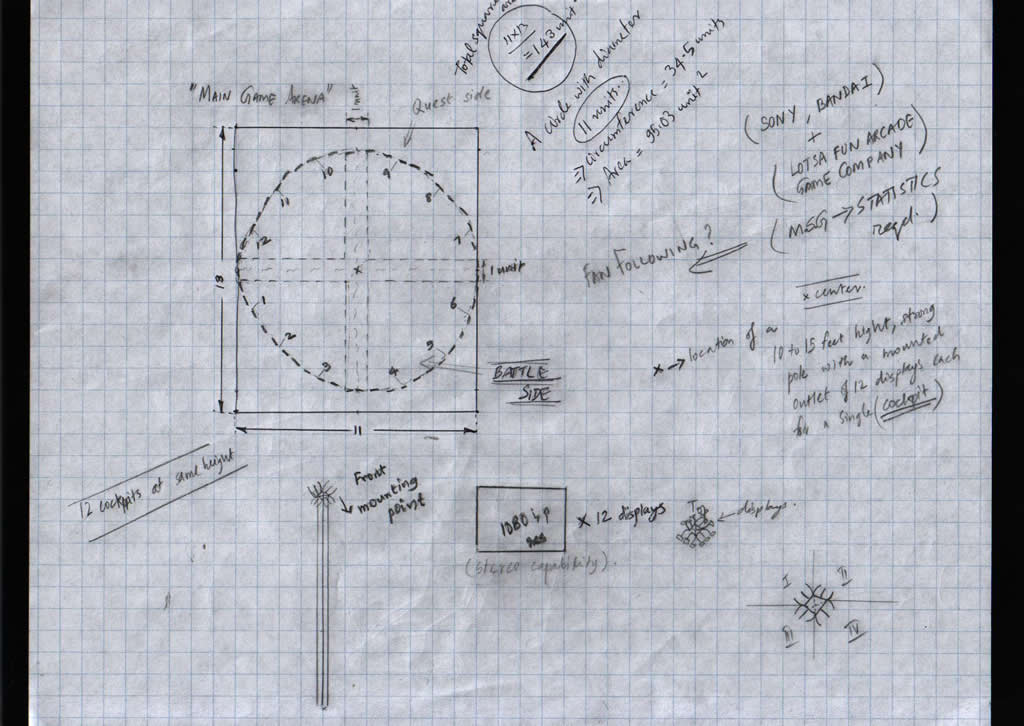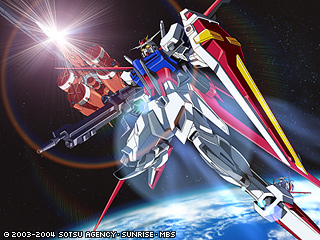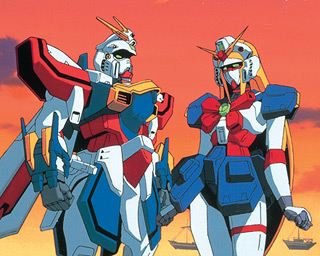 Mobile-Suit Gundam
Mobile-Suit GundamVIRTUAL REALITY - FINAL EXAM - CS528 - Fall 2005
LOTSA FUN GAME ARCADE COMPANY - Read the question here ... http://www.evl.uic.edu/aej/528/finals.html
 Mobile-Suit Gundam
Mobile-Suit Gundam
GAME CONCEPT
A collaborative game world which combines action, Multiplayer Online Role-Playing, Modding-capability and a realistic experience through Virtual reality.
TITLE : Mobile-suit Battle Robot Virtual World (Gundam)
TIME PERIOD : Future
LOCATION: Earth Sphere
USER: A pilot of a custom / built-in Mobile-suit
TIME PER ARCADE EXPERIENCE: 20 mins.
PHYSICAL SPACE
15 X 15 meters square room.
Initial Storyboards showing
areas allocated for different purposes
Fig.1 Showing a sketch separating the main arena from 3 corridors. 1 for entry, 1 for exit and 1 for maintenance.

Fig 2. A calculation of the area of the circle, the space available for the displays/ VR devices and other equipment.
The circular playing arena is in the middle of the 11X13 room. Four elevated quadrant shaped platforms around a central pole which consists of 12 prongs with a mounting point each to mount a the screen of the steroscopic display. 1 meter wide platforms which can be reached by a criss-cross of stairs raising from the centre to all four sides. Stairways allow arches in the middle which act as doors to different areas at the bottom. There are 2 lounges for people waiting and those who are watching the action that is happening upstairs. Two are left for personnel. One side of the corridor is allowed for the A/C vents, other wiring and maintenance with no admission to the public. The other two have a centrally positioned huge arch sliding door. One corridor is allotted for entry and one for exit. The quadrants marked 1 to 6 would be dedicated to the Battle side while the quadrants which are marked 7 to 12 would be the quest / mission side.
HARDWARE
- Virtual Reality Cockpits
Each of the 4 quadrants has 3 cockpits which are designed to immerse the users
into the collaborative virtual environment. Each cockpit has a height adjustable
high-backed cushion chair, wearable haptic devices for both hands. (i.e If the
design with 'The Sarcos Dexterous Arm Master' < http://www.sarcos.com
> is effective). Alternative design would be a simple inertially tracked
smaller scale model of the gun or saber that the mobile-suit would actually
use. They are attached to the side of the cockpit which would have a holster
and a scabbard on both the sides. The chair provides force feedback based on
the movement of the mobile-robot in the virtual world. Immersive nature of the
system could actually increase because of the height of the cockpits. The head
tracking would help the software to keep the orientation of the user in the
huge battle robots realistic and the height of the virtual environment to actual
scale. CH Pro Rudder Pedals are used for navigation. Several other haptic options
like PHANTOM, SPIDAR were considered, but then dropped since they were not applicable/effective
here.
- Graphics
The graphics processors would be a train of Playstation3 consoles combined together
provided that the console still has IBM’s Cell BE Architecture which uses
a 64-bit PowerPC (PPE) and 8 Synergistic Processing Elements.
< http://www-128.ibm.com/developerworks/power/library/pa-cellperf/
>
Theoretically this would increase the graphics processing capability of the
PS3 and allow more realistically rendered environments.
< http://www.ps3blog.net/2005/09/22/multiple-ps3s-working-together/
>

Alternative design: http://www.lightspeeddesign.com
BOXX Technologies - DepthQ High Definition < http://depthq.com/pdf/Depth High Definition Plus computer config.pdf >
AMD Opteron Processors NVIDIA nForce3 250 Pro Chipset AMD 8131 Dual Channel
DDR400 . . (8) DIMM Slots Reg ECC
(6) Serial ATA ports . . (RAID 0, 1) (2) Parallel ATA IDE interface . . (4 devices)
(1) Gigabit Ethernet ports 6 channel audio
. . Front panel mic + audio out (2) IEEE1394a Ports: (1) Front, (1) Rear (6)
USB 2.0 Ports: (2) Front, (4) Rear (1) Serial port
(1) Parallel port Floppy Drive 550W Power Supply 4U: 7"w x 17"h x
18"d Expansion options: (6) 3.5" hard drive bays
(2) 5.25" drive bays (1) AGP 8X (1) PCI-X 64/133 . . or (2) PCI-X 64/100
(2) PCI-X 64/66 (1) PCI 32/33
![]()
Configuration
1 x Dual Opteron Model 248
1 x 1GB DDR400 ECC (2 DIMMS) runs at 400MHz with 248's and higher
1 x NVIDIA Quadro FX 3000 256MB DDR
1 x 80GB 7,200rpm Serial ATA 8MB Cache Drive
1 x 500GB Serial ATA RAID 0 Array (2x 250GB 7,200rpm)
1 x 16x Dual Layer DVD±RW Writer (with Nero software)
1 x Windows 2000 Professional Edition SP4
1 x Black 104 key keyboard
1 x Logitech MX310 corded optical mouse
Display
This is the most tricky part since there are 12 different displays for each cockpit. Commercially available DepthQ 3D projection systems ( Around 1200$ ) were considered. But, it still required a stereo input to project. IBM's new 3D video product that converts the video of a DLP(Digital Light Processing) television was also considered (which costs 1000$), which could still be used if it is commercially available < http://www.physorg.com/news8113.html >. The output from the Graphics processor (either the PS3 or a desktop) would then be fed into a central server that converts the images to stereo using a graphics library. Then, the stereo output from the server would be fed to the DepthQ 3D projection systems spread over all the cockpits. All the display screens are illuminated like this depending upon the requirement. The size of the display would be the maximum size that would fit into a circular room of 5 meter diameter(100 " screens --2.22 x 1.25 m -- 16:9). Yhe distance between the user and the screen would be around 0.7 to 1 m. The Active LCD shutter glasses are worn to view the 3D image. The inertial tracker is attached to one of the sides of the glasses for head tracking.
Hardware Cost
Chair with mechanical feedback < http://www.vrealities.com/intensor.html > - $ 195 x 12
Sarcos wearable haptic feedback arms < http://www.sarcos.com > - around 6000 $ x 24 (or)
<using inertial tracker - instead of haptic wearable arms> Intersense InertiaCube3 - $ 1700 x 24 (or)
<head & hand tracking> Intersense IS-900 MiniTrax devices - starting from 20$ x 24
CH Pro Rudder Pedals - $ 100 x 12
Displays (12 Front Projection screens) - $ 600 x 12
3D Projectors (InFocus DepthQ) - $ 1100 x 12
Central Server - $ 2400
Playstation3 consoles or desktop PCs - $ 1800 x 12
Active LCD shutter glasses - $ 100 x 12
------------------------------------------------------------------------------------ -----------------------
Grand Total - $ 49, 620 <Just the IS-900 MiniTrax> -- Feasible
- $ 49,140 + 144,000 = $ 193,140 < For the wearable haptic feedback arms>
SOFTWARE
The Game
OpenGL would be the best idea if this were to be developed in a system of networked Playstation3 consoles < read this > .This is an Action-packed RPG( Role-Playing Game).Software implementation would require features such as online gameplay, collaborative gameplay and realistic graphics which the Playstation3 can handle effectively. Two quadrants are dedicated to battle-mode which just features one-on-one combat where users gain experience, advance levels; earn credits by winning against other human opponents operating their own mobile suits. Once gamers register for the service, they receive either a PC CD or PS3 Blu-ray Disc containing the mod creating software. They can modify the mobile-suits that they have earned during arcade gaming experience online. But, they cannot modify the strength or effectiveness of their suits which is done automatically and only while they are in the game. To save time in the arcade, only the part where they actually control the battle robots is allowed to the users in the arcade. The pilot character, custom story behind the pilot and characteristics can be defined by the user in the PCs that are in the lounge or customized online by the users. The game would always be multi-player, unless there are no other human players around; in which case an AI character would take over. Custom scenarios and quests can be designed by expert users or users who gain a particular level, say 5 or 6. In the Quest / Mission mode, they can lead other players against the bad bots. Players can also be allowed to play quests as the bad guys. The scenario creator would exactly feature 6 players or less ( Human + AI combined) and would last for 20 minutes. Each player can select 1 out of the 6 characters depending on the level they are in which can also be defined by the author of the scenario. Since, the levels, mobile-suits and characters are customizable it would be an interesting experience everytime the user is in the arcade. Most of the software would use open source and GPL software barring modelers, 3rd-party renderers, sound creating software etc.
Software cost ~~ approx ~~ $ 1000

Network
The network is really important since this is a multiplayer game and also requires pretty high bandwidth. But, since the network for actual gameplay with all the action that sucks up most of the bandwidth can be implemented with dedicated servers just for the arcades it saves the pain of worrying about latency during the experience. The only server that requires to be shared with the internet is the one with other data about the scenarios,users, their credits, inventory, quests, experience and levels. This can be maintained at a website that is dedicated for such mods/scenarios/levels which improve the arcade experience by decreasing monotony. But, to make sure the levels created by users are not malicious they are screened before letting them into the arcade. A dedicated central server with a ISP would be sufficient to maintain the arcades. All the users would be peers connecting to the central server.
Tracker software
Instead of the controllers, the haptic input (or tracker
information) that captures 6 DOF (3 Rotational and 3 Translational) are used
to program the actions during gameplay. The VR cockpit in this particular arcade
differs from the anime series by the fact that eventhough the users are located
in the head or torso of the robot, they need to use haptic input and tracked
hands to move parts of the mobile-suits. Navigation is done using pedals. This
modification is made just to improve immersiveness and remove the joystick interface.
Firmware from the haptic input manufacturers can be used to program the tracker
software.

USER EXPERIENCE
Gameplay experience:
Battle mode:
Deathmatch battle, between 6 players. User attacks other players by moving his gun and hitting enemies. Navigation is done by walking (using the pedals alternatively), running (Walking Fast), flying (Pressure on left pedal or right pedal alone with right or left arm stretched up- if the robot is capable of flying),crouching(Pressure on both pedals at the same time and hold), jumping (Crouching and releasing it in a sec. in crouch mode), transforming (bringing hands together in front of the chest), turning left (Walking + left arm outstretched) and turning right (Walking + right arm outstretched). The gun from the holster (position varies with each robot can be picked up the gun, move the right/left hand (The hand is tracked with respect to the actual mobile-suit) to the correct position and make grasping motion with the thumb (Same with a saber).To attack with a gun point at enemy and make grasping motion. To attack with a saber, grasp and swing at enemy at close range.
P.S : Grasping motion is replaced by "pressing a button" on the scaled down gun model or Saber model if the mechanical arms are not used.
Quest mode:
Players go through a pre-designed scenario killing villains and achieving an objective which should fall within 20 minutes. To pick up and place objects in the virtual environment during quest mode, the grasping motion can still be used. All other controls are similar to the battle mode.
Beginner : - 1.
creates a character at the lounge
2. cannot go to
quest mode unless he/she gains 5 levels.
3. gets a minimal
mobile-suit and fights it out in battle mode
4. If all other
users are experts, more credits are earned for a single hit on other users.
5. Can slowly gain
levels.
Expert :-
(Above level 5)
1. can create scenarios
2. can play quest/mission
mode
3. can gain higher levels
faster in quest mode, but can also lose credits in quest mode if doesn’t
win.

STAFFING
Staff Required Work done
Receptionist - 1 - receives players and provides them with instructions and status.
Janitor - 2 - maintains the arcade space in top-notch condition.
Technician - 2 - makes sure all the equipment is working properly everyday before every run.
Game Support - 2 - helps out new gamers with the nuances of the game.
Electrician - 1 - makes sure the power supply, A/C and other lighting are all working perfectly.